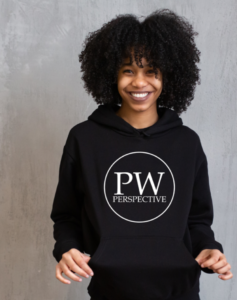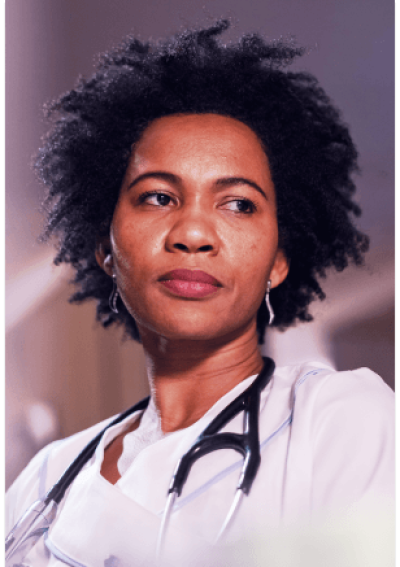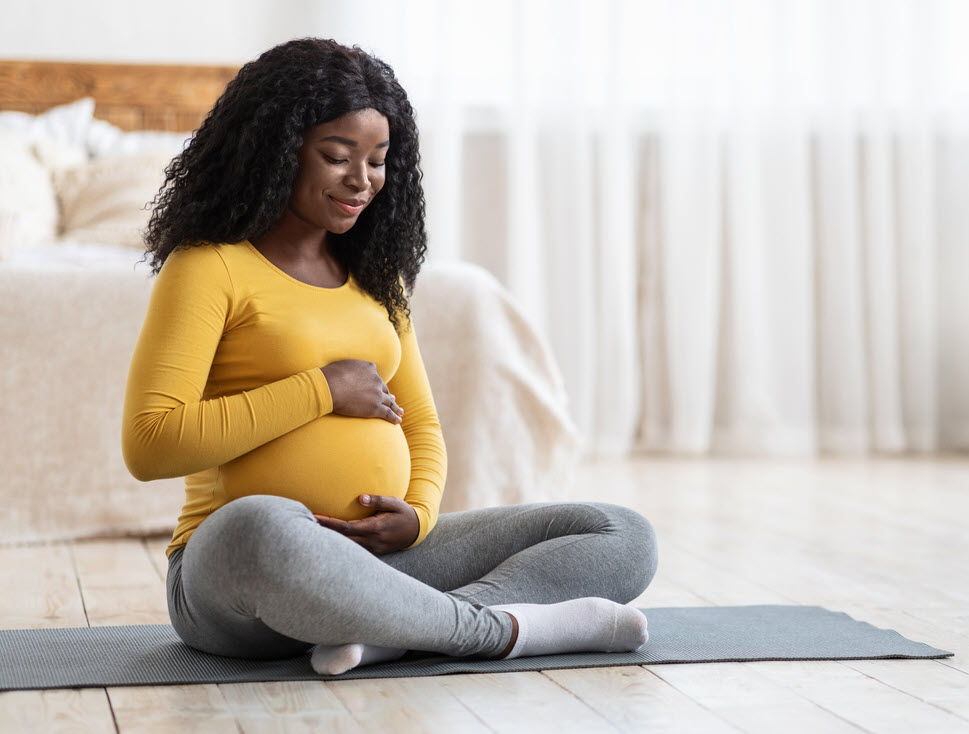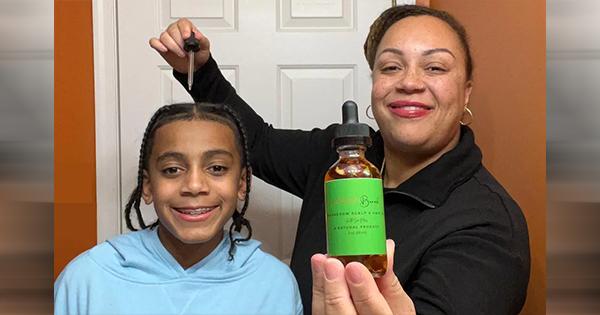How Workplace Hair Discrimination Can Impact the Health of Black Women
The following article is by Terry Turner, and with permission by Consumer Notice.org
Back in 2020, the PW Perspective ran an article on how Black women suffered workplace hair discrimination. However, using chemical hair straighteners to conform to spoken and unspoken rules comes at a significant cost, including scalp damage, pain and an increased risk of developing certain cancers.
Chemical Hair Straighteners: From Discrimination to Cancer
For many Black girls and women, straightening their natural hair helps them avoid hair discrimination at school and the workplace. Natural hair is hair that is unaltered by nonchemical and chemical straighteners, including relaxers and texturizers.
“I experienced workplace bias around 15 years ago when I started locing (coiling, braiding, twisting or rolling) my hair. My boss then asked me why I did something so ugly to my hair,” said Renair Amin, a relationship wellness coach in New York. “I have gone to job interviews in a wig and then ditched it after getting the job.”
Some Black girls and women use chemical hair straighteners to smooth natural hair because nonchemical options aren’t permanent. However, the National Institutes of Environmental Health Sciences’ Sister Study found that chemical hair straighteners may cause adverse health effects on women, including uterine cancer.
“Because Black women use hair straightening or relaxer products more frequently and tend to initiate use at earlier ages than other races and ethnicities, these findings may be even more relevant for them,” said Che-Jung Chang, Ph.D., an author of the study and a research fellow in the National Institute of Environmental Health Sciences Epidemiology Branch.
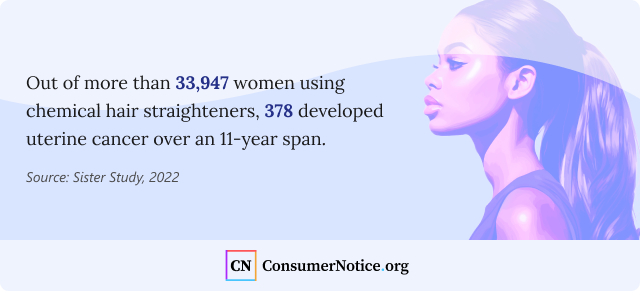
Over 33,947 women participated in the Sister Study, which lasted almost 11 years. During that time, 378 women were diagnosed with uterine cancer.
Despite the risks, studies show some Black women feel pressure to use potentially dangerous products on their hair to ensure economic and social success. Others, like Amin, choose to wear more natural hairstyles.
“Today, I no longer jump through hoops in relation to my hair,” Amin said. “I wear it however I desire.”
Challenges of Natural Hair Bias in the Workplace
The 2021 Natural Hair Bias in Job Recruitment study uncovered evidence of natural hair bias against Black women in the workplace.
Researchers asked 240 Black and white women to review eight images of Black women and eight of white women. Half of the photos showed Black women with natural or straight hair, and the other half showed white women with curly or straight hair.
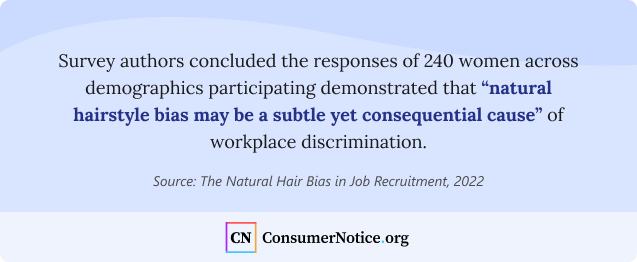
All survey participants then rated the images. Rating categories included perceived professionalism, competence and likelihood of selecting the women for a job interview.
Study authors found that “Black women with natural hairstyles were perceived to be the least professional, least competent, and least likely to be recommended for an interview across all comparison groups.”
The authors concluded that “natural hairstyle bias may be a subtle yet consequential cause” for the adverse workplace outcomes Black women face, including higher unemployment rates than their white female counterparts.
Eurocentric Standards of Beauty
Appearance can be a significant factor for some job recruiters, but it’s challenging to identify the criteria that make someone appear professional.
According to the 2023 CROWN Workplace Research Study, many people historically assumed that a professional appearance should match the physical characteristics of white people. So, regardless of race, women in the workplace were expected to have straight hair rather than natural or textured hair.
Many Black women’s natural hair differs in texture and appearance from their white counterparts. This may cause Black women to think that using chemical hair straighteners or altering their hair in other ways is necessary to be accepted among employers and colleagues.
“At one of my jobs, before our professional photos were taken, I was asked when I was going to fix my hair because I was wearing braids,” said Dr. DeJarra Sims, a naturopathic doctor in California who no longer uses chemical hair straighteners. “What she meant was, when was I going to take out my braids and put straight hair on, whether that was wearing a straight hair wig or straight hair extensions?”
Effects of Workplace Hair Discrimination
Workplace hair discrimination can contribute to detrimental socioeconomic factors. For example, Chenadra Washington, who works in public relations in Houston, Texas, said she wore her natural hair to work one day in 2019. “Walking through the office, I felt stares from all directions,” she said.
After that, Washington said she was uncomfortable wearing her natural hair to work.
Socioeconomic factors related to hair discrimination include:
- Bias: People might be overlooked for promotions, become marginalized, have limited opportunities, receive unfair treatment and experience negative stereotypes.
- Economic Disparities: Limited job opportunities, lack of career advancement, fewer promotions and lower-paid positions can contribute to preexisting socioeconomic inequalities.
- Legal Implications: The CROWN Act (Creating a Respectful and Open World for Natural Hair) protects against bias based on certain natural hairstyles. It has been implemented in several U.S. states.
- Mental Impact: Those who deal with natural hair bias can become overwhelmed with stress and anxiety at work. They may have less confidence and lower self-esteem, impacting overall job satisfaction.
Hairstyle policies have also been an issue for men and women who serve our country. Over the past several decades, the United States military has revised its grooming standards to be more inclusive.
For example, the Army updated its grooming standards in 2021 to include hairstyles like locs, braids and ponytails. The Navy began allowing both men and women to wear their hair short that same year.
The Air Force relaxed its rules in 2020 to include longer hair lengths for men and women. In 2018, the Marines began allowing longer hairstyles and the option of wearing twists in short hair.
What Is the CROWN Act?
The CROWN Act, passed by the U.S. House of Representatives in 2022, aims to ban hair discrimination.
“Natural Black hair is often deemed ‘unprofessional’ simply because it does not conform to white beauty standards,” said New Jersey Congresswoman Bonnie Watson Coleman following the passage of the CROWN Act in the House. “Discrimination against Black hair is discrimination against Black people.”
The CROWN Act covers hairstyles that have historical connections to Black pride, including:
- Afros
- Bantu knots
- Braids
- Cornrows
- Locs
- Tightly coiled or tightly curled hair
- Twists
According to a 2019 study by personal care company Dove, Black women are 30% more likely to receive information about their employer’s formal grooming policy than other women. That same year, Dove partnered with several social justice organizations to work toward a more inclusive experience for Black men and women by advancing the CROWN Act.
While the CROWN Act passed the House, it did not pass the Senate and hasn’t become federal law. However, several states have enacted CROWN Act legislation of their own.
California became the first state to make the CROWN Act a law in July 2019. As of December 2024, 27 states have passed the CROWN Act or other laws prohibiting hairstyle discrimination.
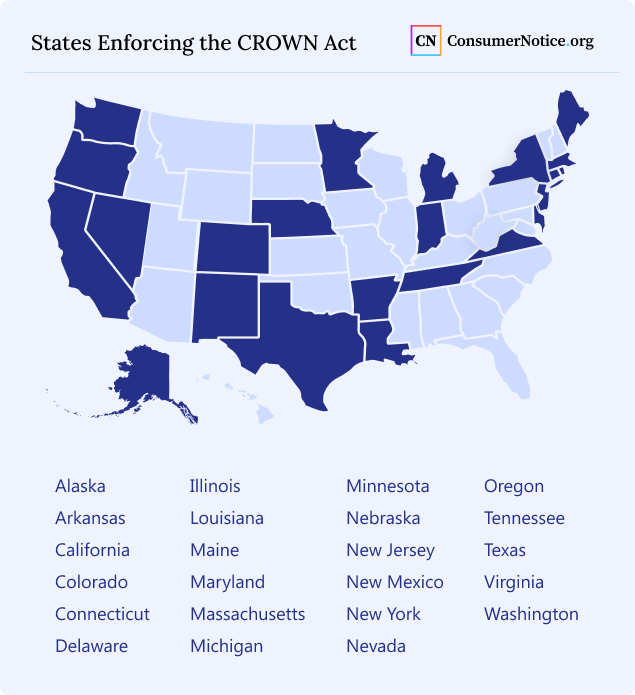
While there has been significant progress, with over half of U.S. states passing the CROWN Act, advocates continue pushing for its adoption in the remaining states and at the federal level.
Over 50 cities, counties and municipalities nationwide, including parts of Arizona, Florida, Georgia, Kentucky, Missouri, North Carolina, Ohio, Pennsylvania, West Virginia and Wisconsin, have enacted the CROWN Act. Washington, D.C., and the U.S. Virgin Islands have also passed race-based hair discrimination laws.
CROWN laws can vary between states, especially regarding education and job-related requirements. Some states have their own versions of the CROWN Act, but these laws may have exceptions permitting unfair treatment in certain situations.
Chemical Hair Straighteners Can Lead to Pain, Injury
Chemical hair straighteners gained popularity in the 1950s. According to the Sister Study, they have the potential to cause cancer, hair damage, scalp burns and hair loss.
“Chemical exposure from hair product use, especially straighteners, could be more concerning than other personal care products due to increased absorption through the scalp which may be exacerbated by burns and lesions caused by straighteners,” said the authors of the Sister Study.
Tonya Herrell, a hairstylist in Ohio, revealed her customers abandoned chemical hair straighteners because of the pain associated with their harsh chemicals. “By the ‘90s, people were getting away from using relaxers because it was noticeably breaking our hair,” she said.
Washington, the public relations professional, said she used chemical hair straighteners from the age of nine until she could no longer tolerate the pain associated with them at the age of 23.
“My scalp was burning so badly I never did it again,” Washington told Consumer Notice.
Timeline of Hair Straightening
The history of hair straightening is long and complex. From the groundbreaking study linking chemical hair straighteners to uterine cancer in Black women to the early days of hair straightening, the techniques, products and styles have evolved.
- 2022The National Institutes of Environmental Health Sciences links chemical hair straighteners to uterine cancer. Women begin filing lawsuits against hair straightener manufacturers.
- 2000sA shift towards Black women wearing their hair naturally begins. Later, social media contributes to the natural hair movement.
- 1990There’s a comeback in the trend of straightening Black hair, follwoing stars like Aaliyah.
- 1970sThe Jheri curl process defines a new style. Sales of the perm, activator and moisturizer spike.
- 1960sBlack women begin emulating straight hairstyles, as seen on Motown’s Black performers on TV.
- 1954George E. Johnson introduces the first permanent hair straightener for men.
- 1909Garrett A. Morgan creates the first chemical hair relaxer.
- 1900sMadam C. J. Walker, a Black entrepreneur, patents a line of hair care products for Black women. She later becomes the first self-made female millionaire in the United States.
- 1880Hot combs arrive in America.
- 1845France debuts hot or pressing combs to temporarily straighten white women’s curly hair.
Attitudes about hair straightening and popular techniques continue to shift. The impacts of studies about the harmful effects of chemical hair straighteners are still developing as lawsuits continue to be filed due to injuries and complications from these products.
Long-Term Health Effects of Chemical Hair Straighteners
The use of chemical hair straighteners has been linked to adverse health effects. According to the National Institutes of Health, researchers reported a connection between chemical hair straighteners and cancer. This includes a greater risk of developing breast and uterine cancers.
Among the most dangerous hair straightening product ingredients is formaldehyde. The International Agency for Research on Cancer classifies formaldehyde as a human carcinogen.
Other hair straightener ingredients, such as parabens and bisphenol A, may also increase serious health risks. These chemicals and formaldehyde may all contribute to side effects like:
- Asthma attacks
- Burning of the eyes, lungs, nose or skin
- Hair loss
- Impaired fertility or infertility
- Increased risk of certain cancers
- Vision loss
Additional research found links between adolescent use of permanents to curl hair and straighteners with a higher risk of premenopausal breast cancer. Girls ages 10 to 13 are particularly at risk because of the potential exposure of breast tissue to the chemicals.
Rise in Chemical Hair Straightener Lawsuits
Since the 2022 National Institutes of Environmental Health Sciences, women have filed a growing number of chemical hair straightener lawsuits. Daniel Nigh, a product liability expert whose law firm represents plaintiffs in these lawsuits, told Consumer Notice that he sees a range of times between chemical hair straightener exposure and cancer diagnoses.
Nigh says that, on average, it takes a decade or more after chemical hair straightener exposure to diagnose cancer. That’s especially dangerous when the Sister Study’s researchers said Black girls and women use these harsh and hazardous products more frequently and at earlier ages than women of other races and ethnicities.
He said hair straightener companies market to Black women extensively, including young children.
“[Hair straightener products] have pictures of six-year-old girls with their hair straight, trying to show that that’s the picture of beauty,” Nigh said. “All the while, they were being subjected to carcinogens at such a young age that would cause them to develop cancers in childbearing ages.”
Nigh expects more plaintiffs will file lawsuits. Meanwhile, hair straightener manufacturers also face class-action lawsuits.
New Developments in Hair Straightener Lawsuits
There have been several significant developments in the lawsuits against hair straightener manufacturers.
In November 2023, Judge Mary Rowland delivered a critical ruling allowing most plaintiffs’ claims to move forward. She dismissed the defendants’ motions to dismiss, allowing claims related to negligence, strict liability, failure to warn and breach of warranty to proceed.
The discovery phase is currently in progress, with both parties sharing evidence. In December 2023, manufacturers were ordered to provide product labels, regulations and safety studies for products sold in other countries.
In July 2024, L’Oréal faced a setback when a court rejected its attempt to throw out a lawsuit related to a hair straightener. The case will continue in Georgia’s state court.
In September 2024, people suing Revlon claimed that the company was slowing the legal process by not providing court-required documents on time.
A Tough Choice: Health or Career?
Social and economic pressures can make women feel forced to choose between their health and career. Some may believe they must use potentially harmful chemicals to straighten their hair or miss out on a job opportunity or promotion.
Sims, the preventative medicine specialist who faced discrimination because of her hair, said she started using chemical hair straighteners at the age of eight. She felt pressure to fit in while she pursued her career as a naturopathic doctor.
“I did not feel comfortable having a natural afro,” Sims told Consumer Notice. “African-American women have always been pressured to straighten their hair.”
She said she felt compelled to use potentially dangerous chemical hair straighteners during her college years to safeguard her career before it began.
“My [college] advisors said, do what you have to do to get into medical school,” she said. “I was being groomed to be a doctor; they won’t accept XYZ, just do it.”
Safer Alternatives or Go Natural?
Hair stylist Herrell said fewer people use chemical hair straighteners now and prefer to go natural. She stopped using the products over 20 years ago.
“A lot of Black women have been going natural,” Herrell said, adding that only a small percentage of her clients use chemicals on their hair. “Only three out of 30 of my clients get relaxers.”
Caleb Backe, a hair expert for Maple Holistics, a plant-based personal care company, agrees that natural hair is becoming a more popular option.
“In recent years, there has been a growing movement toward embracing natural hair texture and reducing reliance on chemical hair straightening methods,” Backe told Consumer Notice. “This shift is partly driven by increased awareness of the potential risks and damage associated with chemical treatments, as well as a desire for more versatile and diverse hairstyles.”
The market for chemical hair straighteners and relaxers has experienced a decline in sales over the past few years. According to Forbes, industry market research firm Kline & Co. said sales of hair relaxers dropped from $71 million in 2011 to $30 million in 2021. Overall sales fell 25% in 2020.
Agnieszka Saintemarie, a Kline & Co. director, said that as sales of chemical hair straighteners continue to fall, “clients prefer more natural hairstyles and turn to styling products or styling appliances as alternatives.”
Safer Hair Straightening Options
According to market research company Emergen Research, sales for nonchemical alternative hair straighteners are expected to grow. The research firm notes that the global hair straightener market is anticipated to rise at a rate of 4.8% by 2030.
Increasing sales for nonchemical solutions indicate a market for those who want to straighten their hair without harsh chemicals, pain and potential health risks.
Some ways to achieve results without putting health at risk include:
Heat
Treating hair with heat can straighten it, but the effect isn’t permanent. Flat irons or blow dryers may also damage hair when overused.
Keratin Treatments
Keratin is a protein that helps form hair, nails and epidermis. These treatments are slightly less harsh on hair than other straightening methods, like relaxers. Keratin temporarily loosens curls but eventually loses its effects, returning the hair to its natural state.
Heat-Free Methods
Air drying or hair stretching can create results without chemicals. More natural methods include hair wrapping and roller setting. These options may not create the same results as other methods, but they are healthier.

Future Outlook of Natural Hair in the Workplace
The CROWN Act protects natural hair in the workplace in nearly half of the country, but the legislation still has a long way to go. Aside from laws, some people believe human resources departments must set higher standards.
According to human resources publication HR Morning, there are several strategies companies can implement to help ensure all employees are treated fairly in the workplace, including:
- Updating or modifying language in employee handbooks and policies to ensure it is inclusive and specific.
- Offering training for managers to clarify unacceptable workplace practices about hair.
- Providing appropriate accommodations to address hair-related concerns if health or safety is an issue.
- Language stating that natural hairstyles are considered professional and appropriate for the workplace can help avoid bias. Also, providing a list of examples may better serve employees.
Language stating that natural hairstyles are considered professional and appropriate for the workplace can help avoid bias. Also, providing a list of examples may better serve employees.
All managers and supervisors who hire, fire or promote employees should:
- Avoid making comments about a job candidate’s appearance.
- Receive best practices training for interviewing applicants.
- Make all unacceptable workplace practices clear.
Policy changes have the potential to create a more inclusive workplace and benefit the health of women who feel they need to use chemical hair straightening products to succeed in their careers.
Remote Work’s Impact on Hair Discrimination
The shift to remote work since COVID-19 has reduced some workplace hair discrimination, especially for Black women, by allowing more freedom in hairstyle choices.
According to a Project Include survey, without the need for daily in-person interactions, many Black women may experience fewer microaggressions, like unwanted comments.
Working from home has also meant less pressure for Black women to alter their appearance, known as code-switching, to have opportunities for professional advancement.
However, remote work hasn’t fully eliminated hair discrimination. Hairstyle biases can persist during interactions like video calls, interviews or performance evaluations.
While remote work has eased some pressures, it hasn’t solved the problem. Real progress depends on companies adopting inclusive policies that address hair discrimination head-on.
Please seek the advice of a qualified professional before making decisions about your health or finances.
